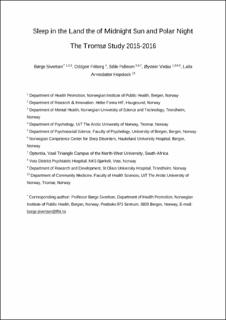| dc.contributor.author | Sivertsen, Børge | |
| dc.contributor.author | Friborg, Oddgeir | |
| dc.contributor.author | Pallesen, Ståle | |
| dc.contributor.author | Vedaa, Øystein | |
| dc.contributor.author | Hopstock, Laila Arnesdatter | |
| dc.date.accessioned | 2021-03-30T10:08:56Z | |
| dc.date.available | 2021-03-30T10:08:56Z | |
| dc.date.created | 2020-12-10T15:49:53Z | |
| dc.date.issued | 2020 | |
| dc.identifier.citation | Chronobiology International. 2020, 38 (3), 1-10. | en_US |
| dc.identifier.issn | 0742-0528 | |
| dc.identifier.uri | https://hdl.handle.net/11250/2736106 | |
| dc.description.abstract | While some diseases and human behaviors fluctuate consistently with season, the extent of seasonal variations in sleep, especially at high latitudes, is less consistent. We used data from a geographic region (69º North) with extremely large seasonal differences in daylight that had the 15 participants blinded for the current study’s hypotheses. Data were derived from the Tromsø Study (2015–2016), an ongoing population-based study in Northern Norway comprising citizens aged 40 years and older (n = 21,083, participation = 64.7%). The sleep parameters included bedtime, rise time, sleep onset latency (SOL), and total sleep time. Insomnia was defined according to recent diagnostic criteria (International Classification of Sleep Disorders; ICSD-3). We found some evidence 20 of monthly or seasonal variation in sleep problems. Insomnia was most common during the winter months among men, but not women. No seasonal or monthly effects were observed for sleep duration. SOL was slightly longer during the winter months, but the differences were small and hardly of any clinical relevance. The small or non-existing seasonal variation in sleep and sleep difficulties indicate that extreme seasonal variation in daylight is of little influence on sleep status. 25 The city of Tromsø is a modern city with considerable level of artificial light, which may contribute to the observed rather stabile sleep patterns throughout the year. | en_US |
| dc.language.iso | eng | en_US |
| dc.publisher | Taylor & Francis Group | en_US |
| dc.relation.uri | https://www.tandfonline.com/doi/full/10.1080/07420528.2020.1845191 | |
| dc.title | Sleep in the land of the midnight sun and polar night: The Tromsø study | en_US |
| dc.type | Peer reviewed | en_US |
| dc.type | Journal article | en_US |
| dc.description.version | acceptedVersion | en_US |
| dc.source.pagenumber | 1-10 | en_US |
| dc.source.volume | 38 | en_US |
| dc.source.journal | Chronobiology International | en_US |
| dc.source.issue | 3 | en_US |
| dc.identifier.doi | 10.1080/07420528.2020.1845191 | |
| dc.identifier.cristin | 1858417 | |
| dc.description.localcode | Locked until 29 November 2021 due to copyright restrictions. This is an Accepted Manuscript of an article published by Taylor & Francis, available at https://doi.org/10.1080/07420528.2020.1845191. | en_US |
| cristin.ispublished | true | |
| cristin.fulltext | postprint | |
| cristin.qualitycode | 1 | |
